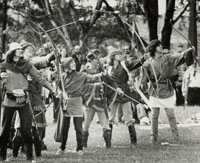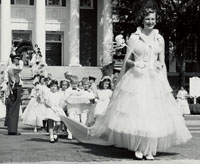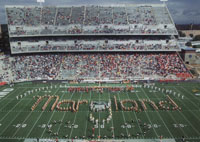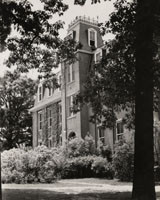MAC to Millennium

"M" — Among the oldest representations of the "M" that still survive on campus are those on Ritchie Coliseum and Turner Hall.
M Book — The university has, at various times, published a student handbook, which for many years was known as the "M Book." This publication included messages from campus administrators, the constitution and bylaws of the student government, rules of behavior, academic calendars, and songs and cheers, among many other items of information that students needed at their fingertips. All incoming freshman received these books to help orient them to campus. Digitized versions of the student handbooks are available on the University Archives website.
M Club — An organization of varsity athletic letterwinners founded in April 1923 by eight men including Dr. Harry Clifton Byrd and seven others representing the current varsity sports. The M Club was instrumental in organizing the university's first Homecoming Day. See also Letterwinner, First Female.
M Club, Women's — Founded on May 26, 1926, and opened to any woman who had received a letter in either of the major women's sports at the University of Maryland at the time: basketball and rifle. By 1934, hockey, soccer, baseball, volleyball, tennis, tenniquoits (ring tennis), riding, and archery had been added. This organization was folded into the main M Club and no longer exists.
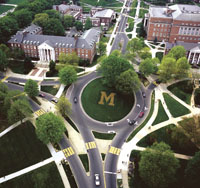
Aerial view of M Circle
"M" Traffic Circle — The former traffic circle on Campus Drive at Regents Drive with flowers in the shape of a letter "M". The "M" is planted twice a year, once in the fall with pansies and again in the spring with annuals, usually vodka begonias. The "M" was created in 1976 by the Department of Physical Plant to commemorate the bicentennial of the founding of the United States. This version of the “M” was relocated to an area adjacent to the Mitchell Building in 2021 as a result of the construction of the Metro system’s Purple Line. An earlier version of the "M" circle sat near the Barracks on Morrill Quad.
MacArthur Fellows — Liz Lerman (Class of 1970) founder of the Dance Exchange in Takoma Park, MD, and a talented dancer, choreographer, and teacher of dance, received a MacArthur Fellowship in 2002. Also selected for a MacArthur Fellowship in 2002 was alumna Karen Hesse (Class of 1975). Ms. Hesse is the author of numerous books for children and young adults and has won many prestigious national awards for her writing. In 1989, Ellendea Profter Teasley (Class of 1966), received a fellowship in recognition of her work as an author, publisher, and translator of Russian literature into English. Another University of Maryland MacArthur Fellow was Peter Miller, an assistant professor of history specializing in early modern intellectual European history; he received his grant in the summer of 1998, shortly before he arrived on campus. In 2004, alumna Naomi Ehrich Leonard (Ph.D., 1994) received a fellowship to support her work on submarines which gather information on environmental conditions beneath the ocean's surface. Two years later, alumnus Kenneth Catania (Class of 1989, B.S. in Zoology) received a MacArthur award to further his research on star-nosed moles and the evolution of mammalian brains. In 2007, Geography professor Ruth DeFries was recognized with a MacArthur award for her work using satellite images of the earth's surface to map the impact human society has on climate and biodiversity. In 2010, David Simon (Class of 1983), an author, screenwriter, and producer best known for his contributions to the HBO show, The Wire, was named a MacArthur Fellow for his new television project, Treme, based in New Orleans in the aftermath of Hurricane Katrina. Selected in 2013, atomic physicist Ana Maria Rey (Ph.D. 2004) was honored for her work in optical lattice clocks; she also contributed to the construction of the most accurate atomic clock ever built. Pamela O. Long, recipient of three degrees from the university (B.A. 1956, M.A. 1969, and Ph.D. 1979), an independent historian of science and technology received a MacArthur fellowship in 2014 to support her work in broadening the "understanding of the role of scholarship and craftsmanship in Renaissance societies and demonstrating how technologies are deeply enmeshed within the broader cultural fabric." Beth Stevens (Ph.D. 2003) received her MacArthur fellowship in 2015 for her ground-breaking research on the function of microglia in the brain. Five years later, alumna N.K. Jemisin (M.Ed 1997), award-winning speculative fiction author, received her fellowship in recognition of her work in “broadening the spectrum of participants in speculative fiction’s creation and surrounding fandom through her published works as well as her world-building workshops, frequent interviews, and active presence on social media”. Reginald Dwayne Betts (Class of 2009), a nationally acclaimed poet, lawyer, scholar and advocate for criminal justice reform who has devoted his career to exploring the effects of violence and incarceration on American society, received his MacArthur Fellowship in 2021; he was recognized for his work promoting the humanity and rights of individuals who are or have been incarcerated. MacArthur Fellows receive grants from the John D. and Catherine T. MacArthur Foundation to support their continued and enhanced creative work and to establish their optimal working and living conditions.
Mace — Ceremonial object carried by the university marshal and used at official convocations and commencement; presented to the university by the Alumni Association on January 20, 1955.
Madrigal Singers — University of Maryland choral group created by Rose Marie Grentzer in 1958. The group attained international recognition in 1964 when the singers visited 11 countries on a 14-week tour sponsored by the U.S. Department of State. The Madrigal Singers disbanded in the mid-1970s.
Marie Mount Hall — Constructed in 1940; designed by Henry Powell Hopkins. Named for M. Marie Mount, dean of the College of Home Economics, in 1967. The addition to the building that faces Memorial Chapel was completed in 1980. Miss Mount's ghost is said to inhabit the building, and Marie Mount is one of the 11 stops on the UMD ghost tour.
Marshall, Thurgood — U.S. Supreme Court Justice Thurgood Marshall will be forever linked to the University of Maryland through the Murray v. Pearson case in the 1930s that led to the integration of the university's law school in Baltimore. Marshall was part of a team of lawyers who represented Donald G. Murray in his efforts to gain admission to the school, which was ultimately successful. Later, Murray was the lawyer who represented Hiram Whittle in his suit to force integration of the College Park campus nearly 20 years later.
Martin, Glenn L., Wind Tunnel Building — Constructed in 1949; named for Glenn L. Martin, aircraft pioneer. Martin became the first person to take motion pictures from the air when he flew Mary Pickford in the silent film A Girl of Yesterday in 1915. He is also credited with developing the first automatic parachute. The top speed that can be achieved when the tunnel is empty is 230 miles per hour. See also Wind Tunnel.
MaryPIRG — Student organization founded in 1973 to effect significant social changes. Issues students have tackled included tenant's rights, promoting energy efficiency, reducing pesticides in schools, and shaping consumer environmental legislation.
Maryland Agricultural College — Chartered on March 6, 1856, and opened to students on October 5, 1859. Original name for the University of Maryland, College Park, campus.
Maryland Book Exchange — An alternate source for students to buy books and other Terrapin gear; not owned or operated by the university. Razed to make way for the Landmark apartment building on the corner of Rt. 1 and College Avenue that opened in fall 2015.
Maryland Chorus — The Maryland Chorus was created in 1967 for a special performance of Beethoven's Ninth Symphony with the National Symphony Orchestra at the Merriweather Post Pavilion in Columbia, Maryland. It was comprised of members of the university community as well as residents of College Park and the surrounding communities, helping to strengthen ties between the campus and its neighbors. In 2001, the Chorus completed a 20-year project with the Maryland Handel Festival, performing all of Handel's English oratorios in chronological order of composition and in their original form. The group ended its 40-year history with a concert featuring Bach's Cantata No. 106 and two works by Fauré, "Pavane" and "Requieum," on May 10, 2009.
Maryland Day — An annual university event held each year on the last Saturday in April, starting in 1999. Maryland Day includes over 400 free events across campus, in addition to demonstrations, exhibitions, performances and food. The event serves as an open house for the university and local community as well as prospective and accepted students, with many academic departments holding special events and orientations.
Maryland Madness — Previously known as Midnight Madness. Annual celebration that kicks off practice for the UMD men's and women's basketball teams. Name changed to Maryland Madness in 2006 to reflect the earlier start time for the event in an effort to make it more family-friendly.
Maryland Medieval Mercenary Militia — Student group interested in medieval times, customs, and battles. The group recreated the Battle of Hastings on campus.
Maryland Stadium — Originally named Byrd Stadium. Constructed in 1950. Full capacity is 48,055 people. Maryland beat Navy 35-21 in the opening game on September 30, 1950. Maryland quarterback Jack Scarbath scored the first touchdown in the new stadium. The red M painted on the seats in the west endzone first appeared for the 1991 football season. Name changed to SECU Stadium, effective October 1, 2022.
Maryland State College of Agriculture — Name for the University of Maryland during the years 1916 to 1920.
Maryland State Athletic Hall of Fame — As of 2019, 32 former Terps are members of the Maryland State Athletic Hall of Fame. For a complete list of all MSAHOF inductees, see the Maryland State Athletic Hall of Fame website.
Maryland Women's Basketball Under the Shell — Reality-based 13-episode TV series originally produced by former Terp football star Jess Atkinson. The show, which debuted on January 9, 2005, on Comcast SportsNet and is now seen on NBC Sports Washington, follows head Maryland women's basketball coach Brenda Frese and her team throughout the season.
Maryland Women's Hall of Fame — Established in 1985 by the Maryland Commission for Women and the Women Legislators of Maryland, the Maryland Women's Hall of Fame seeks to honor Maryland women who have made unique and lasting contributions to the economic, political, cultural, and social life of the state and to provide visible models of achievement for tomorrow's female leaders. Inductees with a University of Maryland connection include Dan of Women Adele Stamp (1990); Director of Athletics Deborah Yow (2003); faculty members Virginia Beauchamp (2003), Eugenie Clark (1989) Rita Colwell (1991), and Mary Shorb (1987); and alumnae Vivian Simpson (2004), Bernice Sandler (2010) and Dominique Dawes (2019).
Mascot — Diamondback terrapin nicknamed "Testudo" who is immortalized in a bronze statue, given by the Class of 1933, in front of McKeldin Library. There are now six more statues of Testudo on campus: two in Maryland Stadium, one at the Xfinity Center, one in the Stamp Student Union, one outside Van Munching Hall, and one at the Samuel Riggs IV Alumni Center. Selection of the terrapin as the mascot was originally approved by Harry Clifton Byrd and was made official by the Maryland General Assembly in 1994. The university's athletic teams are known as the Terrapins, or Terps for short. See also Testudo and "Fear the Turtle."
Master's Degrees — The first master's degrees given by the University of Maryland after the establishment of the Graduate School in 1919 were awarded to Chunjen Constant Chen and Clarence Bobo Nickels in 1920. Both men received the Master of Science degrees. The first master's degrees granted by the Maryland Agricultural College were awarded in 1874. The first master's degree awarded to a female student was to Alma H. Preinkert, who received her M.A. in 1923. The first known Master's in Business Administration (M.B.A.) awarded to a female student was to Victoria Sharp Rymer in 1966. See also Graduate Studies.
Mathematics, Department of — The Department of Mathematics can trace its origins to the earliest days of the Maryland Agricultural College. When the college opened its doors to students in October 1859, one of the first three members of the faculty was H. Dorsey Gough, professor of the exact sciences, including mathematics, pure and mixed; surveying, mensuration, engineering and construction, mechanics and astronomy. For more information on the history of the department , see the Department of Mathematics's website.
May Day — Spring festival established by Dean of Women Adele Stamp in 1923. Co-eds performed elaborate pageants and dances and crowned a queen and her court. The yearbook traditionally made its first appearance each year at May Day as well, and rising seniors were tapped for membership in the women's Mortar Board honorary society. The last official May Day was held in 1961.
McKeldin Library — Largest if the six libraries on campus. Constructed in 1958; designed by Henry Powell Hopkins and Allan Burton; named for Theodore R. McKeldin, Governor of Maryland, 1951-1959.
McKeldin Mall — From building face to building face, McKeldin Mall includes approximately 709,104 square feet or 16.28 acres. The distance from the front doors of McKeldin Library to the front doors of Main Administration is 1, 343 feet. From the front doors of Symons Hall to the front doors of Marie Mount, the Mall spans 528 feet, narrowing as you near the western end, covering only 483 feet from the front doors of Jimenez Hall to the front doors of Chincoteague Hall. The mall originally continued to Anne Arundel Hall and was considered to be the largest academic mall in the country. The Mall was renovated in 1990 when the current configuration of sidewalks and fountains was put into place. The only mall on a college or university campus that is larger in terms of width and length than McKeldin Mall is The Oval at The Ohio State University in Columbus, OH. The Mall features a Peace Garden at its east and the ODK Fountain in the center.
McKeldin Mall Fountain — 16 feet by 250 feet fountain honoring members of the campus chapter of the Omicron Delta Kappa honor society. Each fountain tier represents one of the leadership qualities found in ODK members. Engravings around the fountain include quotations from Franklin Delano Roosevelt and Martin Luther King, Jr., the symbol of ODK, and a listing of fraternity members from the university; this installation also features a plaque honoring donors who contributed to the building of the fountain. View more information about the ODK Fountain and a live stream of activity around the fountain. See also ODK Fountain.
Medal, University — Since May 2000, given to the graduating senior(s) "who best exemplifies academic distinction, extraordinary character, and extracurricular contributions to the campus or public communities." See the list of University Medal recipients for more information.
Medal of Honor Recipients — Two UMD alumni have received the Medal of Honor, Tom Norris, Class of 1967, and Florent Groberg, Class of 2006. Norris' citation recognizes his role in an "unprecedented ground rescue of two downed pilots deep within heavily controlled enemy territory in Quang Tri Province" during the Vietnam War. Groberg was cited for his "acts of gallantry and intrepidity at the risk of his life about and beyond the call of duty while serving as a Personal Security Detachment Commander for Task Force Mountain Warrior, 4th Infantry Brigade Combat Team, 4th Infantry Division, during combat operations against an armed enemy Asadbad, Kunar Province, Afghanistan on August 8, 2012.
Memorial Chapel — see Chapel.
Microbiology Building — Built in 1932, originally as the home of the United States Bureau of Mines. The federal government transferred ownership of the building to the university in 1968, and it was renamed the Microbiology Building in 1980.
Midnight Madness — Charles "Lefty" Driesell, Maryland's men's basketball coach from 1969 to 1986, is generally credited with coining the term "Midnight Madness," a now-annual event commemorating the first day of practice for the college basketball season. The first Midnight Madness occurred on October 15, 1971, at 12:03 a.m., with the men's basketball team heading out for a run surrounded by 3,000 fans. This run was re-created to open fall practice in 2018. Midnight Madness has become a highly anticipated, highly charged annual event, often featuring fireworks, a laser light show, and the return of alumni players. Widely covered by the local and national press, the University of Maryland's Midnight Madness celebration has even served as a broadcasting site for Dick Vitale, the world-famous college basketball television broadcaster. Maryland first televised Midnight Madness on October 15, 2004. The broadcast featured Johnny Holliday, Chris Knoche, Tim Strachan, and Chick Hernandez. Event is now known as Maryland Madness, since it occurs earlier in the evening.
Mighty Sound of Maryland — Current name for the university's marching band, which was originally organized in 1908 by L. G. Smith, the college bugler. The first Cadet Band consisted of four cornets, two clarinets, three alto horns, a baritone horn, two bass horns, three trombones, a snare and bass drum, and cymbals. During the 2019 season, the band consisted of 247 members, including brass, woodwinds, drumline, silks, and dancers. Following every home football victory, the band marches back to the Clarice Smith Performing Arts Center with their hats on backward. The band welcomed its first female director, Andrea E. Brown, in 2018.
Miller, Thomas V., Jr. Administration Building — The University System of Maryland Board of Regents approved the re-naming of the Main Administration Building for Maryland State Senate President Emeritus Thomas V. “Mike” Miller, Class of 1964, in June 2020. Miller served as president of the Senate from 1987 to 2019 and has been a significant supporter of the University of Maryland throughout his time in the Senate The building was originally constructed in 1940 and houses the Office of the President and offices for the Senior Vice President for Academic Affairs and Provost, the Vice President for Administration and Finance, the Vice President for University Relations, and Extended Studies.
Miss D.C. — Only one Terp is known to have captured the title of Miss D.C. and participated in the Miss America pageant, Ashley Boalch, who won the crown in 2011.
Miss Maryland — As of 2019, 23 Terps have been crowned Miss Maryland and participated in the Miss America pageant. The earliest was Marie Lorriane True, in 1959.
Miss USA — Only one Terp, Adrianna David, has been both Miss Maryland USA and Miss Maryland, Ms. David won the former title in 2017 and represented Maryland in the Miss America pageant the following year. An additional Terp, Michae Holloman, Class of 2003, represented the state of Maryland in the Miss USA competition, in 2007. Kelly George, Class of 2000, represented Arkansas in the Miss USA competition the same year. Nicole Ortiz, Class of 2005, represented Maryland in the Miss USA pageant in 2009.
Mitchell Building — Constructed in 1958; designed by Ted Englehardt and named for Clarence Mitchell, Jr., in 1988. The building features a dedication plaque honoring Mitchell and an oil portrait of the civil rights leader, which was a gift of the Black Faculty and Staff Association. The Mitchell Building was originally called North Administration or Administration Annex.
Mitzpeh — Student newspaper whose core goal was "to help students and faculty of this campus better understand Jewish life at the school and to report on events affecting the Jewish population here." First issue published September 14, 1983. Mitzpeh moved to online publication after ceasing to publish in hard copy with the November 2015 issue. Back issues are accessible via the UMD Student Newspapers database.
Montgomery Hall — Dormitory constructed in 1954; named for Montgomery County, Maryland.
Monuments Men — Harold J. Clem, assistant professor of history at UMD from 1943 to 1945, served as part of the Allies' Monuments, Fine Arts, and Archives (MFAA) staff seeking to reclaim more than five million cultural objects seized by the Germans during World War II. The work of these dedicated men and women in the war's aftermath was captured on the silver screen in the movie Monuments Men starring George Clooney, released in 2014. Read more about Clem's MFAA work.
Morrill Hall — Constructed in 1898; named for U. S. Senator Justin S. Morrill of Vermont, the father of the Morrill Land Grant Act of 1862. Morrill Hall is the oldest building on campus whose facade has remained virtually unchanged. One of the haunted locations on the UMD ghost tour.
Morrill Land Grant Act — Federal legislation enacted in 1862 to create a series of colleges to teach agriculture and the mechanic arts, supported by funds from the sale of public lands allocated to the states. When Maryland accepted the proceeds from the act in 1864, the state had 2 senators and 5 representatives in the U.S. Congress. Thus, according to the formula set forth in the act, the Maryland General Assembly designated the Maryland Agricultural College as the state's land grant institution, and the university continues to receive a small amount on income from the proceeds of this sale.
Mote, C.D., Jr., Engineering Laboratory Building—The university named the Engineering Laboratory Building, home to such hubs as the Advanced Propulsion Research Laboratory and Center for Advanced Life Cycle Engineering, in honor of former UMD president C.D. “Dan” Mote, Jr. in October 2021. The Incentive Awards Program (IAP) was also named for Dr. Mote at the same ceremony.
Motto, Formal — The University of Maryland does not have a formal motto. The Calvert family motto, "Fatti Maschii, Parole Femine" which, loosely translated, means "Manly deeds, womanly words," did appear on some versions of the university's seal prior to 1998, when the current seal that contains the globe in all four colors of the Maryland state flag was adopted.
Motto, Informal — In 1988, the university adopted the informal motto "I'd Rather Be Studying," a phrase that has been translated into more than 30 languages and plastered on bumper stickers, posters, T-shirts, hats, pencils, and other campus gear. The motto is based on the fictional story of Sara Bellum, a student at the university who allegedly died from lack of study. "I'd Rather Be Studying" were the last words that Sara recorded on her final mid-term exam.
"Fear the Turtle" became a popular informal athletic motto when the men's basketball went to the 2001 NCAA Final Four.
Movie Script — The only work of an alumnus known to have graded the silver screen is Munro Leaf's The Story of Ferdinand, which Walt Disney turned into an Academy Award-winning seven-minute cartoon.
Movies — Portions of the movie St. Elmo's Fire, directed by Joel Schumacher, were filmed on campus on Fraternity Row in October 1984, and alumnus Redge Mahaffey also used the campus as a setting in his 1995 production Life 101. The 2007 production National Treasure: Book of Secrets, directed by Jon Turteltaub, used McKeldin Mall and the Special Events Room in McKeldin Library as filming locations.
Multi-Ethnic Student Education, Office of — Originally created in July 1972 as the Office of Minority Student Affairs. In July 1973, the name was changed to Office of Minority Student Education, and in September 1973, the office was assigned to the Division for Academic Affairs. It became the Office of Multi-Ethnic Student Education (OMSE) in July 1992. OMSE provides outreach, academic programs and support to multi-ethnic undergraduates in an effort to increase matriculation, retention, and graduation rates for this population of students.
Muppets — Internationally-known fanciful characters created by alumnus Jim Henson. Henson first created the Muppets while still a student at the University of Maryland. The word "Muppets" is a combination of "puppet" and "marionette."
Music Video — The rock group Hootie and the Blowfish filmed a portion of the video for their hit "Only Wanna Be With You" on the floor of Reckord Armory. Maryland basketball player Walt Williams, #42, is among the group shooting hoops in part of the video.
Musical Group — The first documented musical group on campus was the Glee Club, whose activities are described in the 1894 issues of the student publication Cadet's Review.

